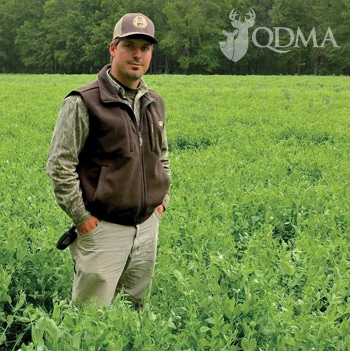Austrian winter pea (Pisum sativum) is a cool-season annual legume that has long been considered a high-preference forage for whitetails. Due to its nitrogen-fixing ability, winter pea has numerous agricultural uses, and it is very easy to establish in fall food plots.
Widely Adapted Deer Forage
Winter pea is considered a cool-season annual legume, although it can be successfully grown in the spring/summer in cooler regions. It is a low-growing, viney plant that can reach 2- to 4-feet tall, depending on soil fertility and management. The stems are hollow and slender, and the fleshy leaves are pale green with toothed margins. It also contains branched, slender tendrils on the top of the plant. Winter pea produces flowers in the spring, which are pinkish-purple in color. If plants are not overgrazed, seed production can occur through pods that are 2- to 3-inches long that contain several round seeds.
Winter pea grows well virtually anywhere within the continental United States and parts of Canada. As the name implies, it has good winter hardiness and can withstand very cold conditions. It grows well in a variety of soil types, but best production occurs in light-textured loamy soils. Winter pea is somewhat sensitive to soil pH, thus, the pH needs to be maintained above 6.0, which already needs to be the goal for any food plot to maximize nutritional quality and attraction.
Germination of winter peas would be considered moderate relative to other cool-season forages, and grazing resistance would be considered moderate as well. Once established, they are capable of producing lots of quality forage for a period of seven to eight months, ranging from 1.5 to 2 tons/acre dry weight. Crude protein in the leaves and stems typically exceeds 25 percent, which is excellent. It is also highly digestible (acid detergent fiber values have been reported below 20 percent), which is an important consideration when selecting forages to plant.
With regard to deer selectivity or preference, results can vary. In Georgia, wildlife biologist Kent Kammermeyer found that deer selected for winter peas in one of his plots that contained wheat, crimson clover, hairy vetch, and winter pea, despite being in an area with a low deer density. Conversely, in Tennessee Dr. Craig Harper found that deer used winter peas sparingly when other cool-season forages were available in areas with a low deer density. However, in high deer density areas, nearly 100 percent of winter peas were consumed.
In Alabama last season, we also observed heavy use of winter peas on a property with a high deer density. Deer observation rates in the 10-acre winter pea field were consistently high. Below, wildlife biologist Seth Basinger is seen standing in the field. 
Soil Preparation & Planting
Prior to planting winter peas, a soil test should be conducted to determine lime and fertilizer needs to get nutrient levels in the high range (remember, winter peas do best with a neutral pH). Adding nitrogen (N) fertilizer isn’t necessary since winter pea is a legume and produces its own, however phosphorus (P) and potassium (K) should be applied at the recommended rates. Also, remember to inoculate winter pea with strain C unless using pre-inoculated seed. Doing so will help ensure healthy, vigorous plots that can endure adverse weather conditions and heavy browsing pressure.
Winter peas are very easy to establish and should be broadcast at a rate of 50 lbs./acre into a well-prepared seedbed, or they can be drilled at a rate of 30 lbs./acre with a no-till drill. If broadcasting peas, be sure to follow up with a light disking to cover the seed approximately 1 to 2 inches. If no-till planting, be sure to kill the existing vegetation with glyphosate a couple weeks prior to planting to eliminate weed competition and create a clean field prior to drilling seed.
With regard to planting dates, winter peas should be planted in September through October in the South. In northern states it should be planted in August, or in April for a spring/summer planting.
Avoid planting winter pea in pure stands. Instead, plant them in a mixture with other preferred species to extend the life of the food plot and minimize the risk of crop failure, overgrazing, and other problems. Winter pea is a great companion to various clover and cereal grain mixtures. Just remember to reduce the planting rates of each species according to the number of species used in the mixture. You’ll find specific recommended blends in QDMA’s book, Quality Food Plots, available in the online store.
In the full profile in Quality Whitetails magazine, I covered weed control options for Austrian winter peas. To start receiving more information about food plot management, become a member of QDMA today.











































